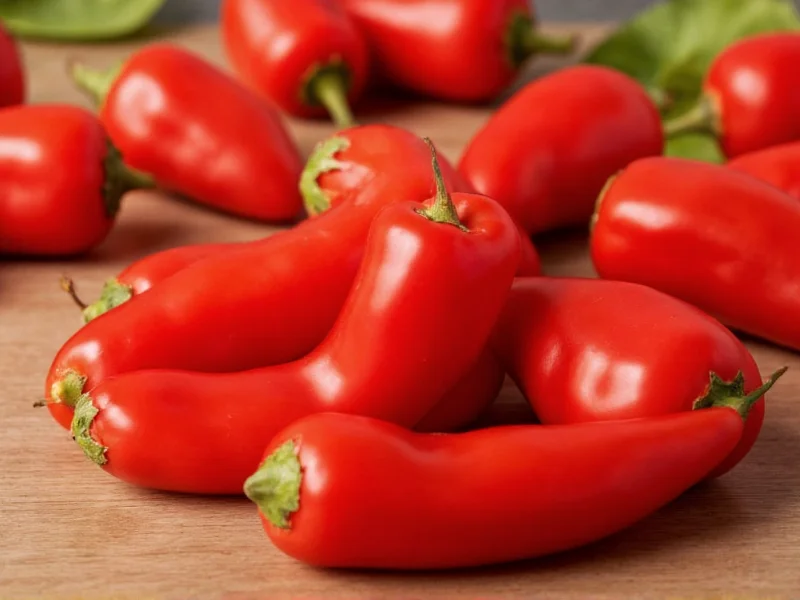Understanding the precise calorie content of peppers helps with meal planning and dietary management. This comprehensive guide breaks down calorie counts by pepper variety, explains nutritional context, and provides practical information for health-conscious eaters.
Calorie Breakdown by Pepper Type
Pepper varieties differ significantly in calorie content. The USDA National Nutrient Database provides standardized measurements that help track nutritional intake accurately. Below is a detailed comparison of common pepper types:
| Pepper Type | Size | Calories | Carbohydrates (g) | Protein (g) |
|---|---|---|---|---|
| Green Bell Pepper | Medium (119g) | 24 | 5.9 | 1.2 |
| Red Bell Pepper | Medium (119g) | 31 | 7.2 | 1.5 |
| Yellow Bell Pepper | Medium (119g) | 32 | 7.5 | 1.5 |
| Jalapeño Pepper | Medium (14g) | 4 | 0.9 | 0.2 |
| Habanero Pepper | Medium (8g) | 12 | 2.9 | 0.5 |
| Cayenne Pepper | 1 tsp (0.8g) | 6 | 1.4 | 0.3 |
Factors That Affect Pepper Calorie Counts
Several variables influence the exact calorie content when determining how many calories in a pepper. Understanding these factors helps create more accurate meal plans.
Size and Weight Variations
Pepper sizes vary considerably between grocery stores and growing seasons. A small bell pepper might weigh 90g (18 calories), while an extra-large specimen could reach 200g (40 calories). When tracking calories in bell peppers for weight loss, weighing your produce provides the most accurate measurement.
Preparation Methods
How you prepare peppers significantly impacts their calorie density:
- Raw peppers: Maintain lowest calorie count (24-32 calories per medium bell pepper)
- Grilled or roasted: Calories remain similar, though water loss may concentrate nutrients
- Stuffed peppers: Can increase to 150-300 calories depending on filling
- Pepper-based sauces: Hot sauce contains minimal calories (1-5 per serving), while cream-based pepper sauces add significant calories
Nutritional Value Beyond Calories
Peppers offer impressive nutritional benefits that extend far beyond their low calorie count. A medium red bell pepper delivers 169% of your daily vitamin C requirement and 15% of vitamin A. The calorie to nutrient ratio makes peppers an excellent choice for nutrient-dense eating.
When considering how many calories in a pepper versus nutritional payoff, bell peppers stand out for their vitamin content:
- Vitamin C: Red peppers contain nearly 3x more than green varieties
- Vitamin A: Increases as peppers ripen from green to red
- Vitamin B6: Supports metabolism and brain health
- Fiber: Approximately 2.5g per medium pepper (10% of daily needs)
Peppers in Dietary Planning
For those tracking calories in bell peppers for weight loss, these vegetables offer significant advantages. Their high water content (92%) and fiber create satiety with minimal calories. Adding sliced bell peppers to meals increases volume without substantially increasing calorie counts.
Nutritionists often recommend peppers for specific dietary approaches:
- Keto diets: Green bell peppers (2g net carbs per 50g) fit better than riper varieties
- Diabetes management: Low glycemic index (15) makes peppers suitable for blood sugar control
- Weight loss plans: 24 calories per green pepper provides crunch and flavor without excess calories
Common Misconceptions About Pepper Calories
Several myths persist about pepper nutrition. Some believe spicy peppers like jalapeños have more calories than sweet varieties, but heat comes from capsaicin, not caloric content. A medium jalapeño contains only 4 calories, making calories in a jalapeño pepper negligible in most diets.
Another misconception suggests cooking peppers destroys all nutritional value. While vitamin C decreases with heat exposure, other antioxidants like carotenoids become more bioavailable when cooked. The calorie count remains stable regardless of preparation method.
Practical Tips for Using Peppers
Maximize the nutritional benefits of peppers with these evidence-based strategies:
- Store whole peppers in the crisper drawer for up to 2 weeks to maintain freshness and nutrient content
- Cut peppers just before use to preserve vitamin C, which degrades when exposed to air
- Pair peppers with healthy fats like olive oil to increase absorption of fat-soluble vitamins
- Add bell peppers to salads, omelets, or stir-fries for flavor without significant calorie addition
Comparing Peppers to Other Vegetables
When evaluating calories in a pepper versus other produce, peppers rank among the lowest-calorie vegetables. A medium bell pepper contains fewer calories than an equal portion of carrots (30 calories) or beets (35 calories), while providing superior vitamin C content. Understanding pepper calorie count by color helps select varieties that match specific nutritional goals.











 浙公网安备
33010002000092号
浙公网安备
33010002000092号 浙B2-20120091-4
浙B2-20120091-4